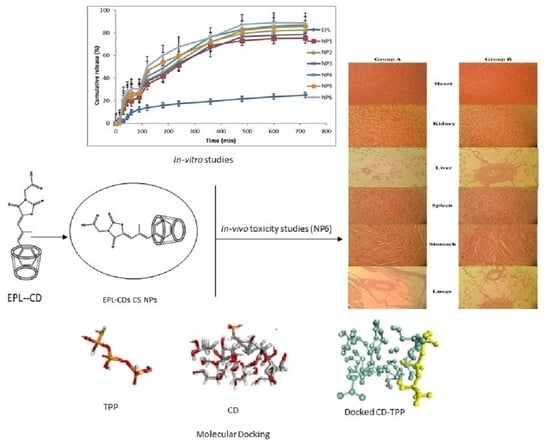Utilization of Gelling Polymer to Formulate Nanoparticles Loaded with Epalrestat-Cyclodextrin Inclusion Complex: Formulation, Characterization, In-Silico Modelling and In-Vivo Toxicity Evaluation
Abstract
:1. Introduction
2. Experimental Details
2.1. Chemicals and Reagents
2.2. Methodology
2.2.1. Preparation of Binary System
Physical Mixing Method (PM)
Kneading Method (KM)
Co-Precipitation Method (CP)
2.2.2. Preparation of Drug Unloaded CS/sTPP NPs
2.2.3. Preparation of EPL-CDs Loaded CS NPs
2.3. Characterization of EPL-CDs-CS NPs
2.3.1. Particle Size, Zeta Potential (ζ) and Polydispersity Index (PDI)
2.3.2. Yield (% w/w)
2.3.3. EPL Entrapment Efficiency in NPs
2.3.4. Fourier Transform Infrared Spectroscopy (FT-IR)
2.3.5. Powder X-ray Diffraction Pattern (PXRD)
2.3.6. In-Vitro Studies
2.3.7. Drug Release Kinetics
Zero-Order Kinetics
First Order Kinetics
Higuchi Model of Kinetics
Korsmeyer-Peppas Release Kinetics
2.3.8. In-Silico Molecular Docking
2.3.9. Morphology of Prepared NPs
2.3.10. Differential Scanning Calorimetry (DSC)
2.3.11. Toxicity Studies
3. Results and Discussion
3.1. Formation Mechanism for CS/sTPP NPs
3.2. Evaluating the Condition for the Optimization of NPs
3.2.1. Effect of Concentration of CS
3.2.2. Effect of Volume of sTPP
3.2.3. Effect of Concentration of AA
3.2.4. Effect of pH on CS Solution
3.2.5. Optimization of CS/sTPP Ratio
3.3. Characterization of Prepared NPs
3.3.1. Particle Size, Polydispersity Index, Zeta Potential
- Cs/sTPP NPs are considered the best solubilization technique for insoluble drug substances.
- Recently, CD complexed CS/sTPP NPs have been reported to have beneficial effects for hydrophobic drugs.
- EPL has demonstrated the ability to interact with β-CD, a characteristic that could enhance the drug solubility, stability, and drug release profile, thereby increasing its ability to successfully incorporate into the NPs matrix system.
3.3.2. Entrapment Efficiency (EE)
- The complexation of EPL with CDs.
- The inclusion of the complexed EPL into the nano-carrier system.
3.3.3. Yield (%)
3.3.4. Fourier Transform Infrared Spectroscopy (FT-IR)
3.3.5. Powder X-ray Diffractometry
3.3.6. In-Vitro Drug Release Study of EPL Loaded CS NPs
- Solubility
- Drug diffusion from polymer
- Diffusion of surface-bound and adsorbed drug
- Erosion followed by degradation of the matrix of NPs [47]
3.3.7. Kinetic Modelling
3.3.8. Molecular Modelling
3.3.9. Differential Scanning Calorimetry
3.3.10. Morphological Evaluation
3.3.11. Toxicity Studies
3.3.12. Biochemical and Histopathological Evaluation
4. Conclusions
Author Contributions
Funding
Institutional Review Board Statement
Informed Consent Statement
Data Availability Statement
Acknowledgments
Conflicts of Interest
References
- Alvi, Z.; Nazir, I.; Javed, Z.A.; Abbas, G.; Hanif, M.; Shehzad, M.A. Orodispersible Tablets of Epalrestat for Immediate Release Studies. Lat. Am. J. Pharm. 2019, 38, 813–820. [Google Scholar]
- Oates, P.J.; Mylari, B.L. Aldose reductase inhibitors: Therapeutic implications for diabetic complications. Expert Opin. Investig. Drugs 1999, 8, 2095–2119. [Google Scholar] [CrossRef] [PubMed]
- Furuishi, T.; Takahashi, S.; Ogawa, N.; Gunji, M.; Nagase, H.; Suzuki, T.; Endo, T.; Ueda, H.; Yonemochi, E.; Tomono, K. Enhanced dissolution and skin permeation profiles of epalrestat with β-cyclodextrin derivatives using a cogrinding method. Eur. J. Pharm. Sci. 2017, 106, 79–86. [Google Scholar] [CrossRef]
- Jagtap, S.; Magdum, C. Technology, Influence of Water-soluble polymers on Epalrestat ternary complexation by kneading. Res. J. Pharm. Technol. 2019, 12, 3602–3608. [Google Scholar] [CrossRef]
- Naik, J.; Rajput, R.; Singh, M.K. Development and Evaluation of Ibuprofen Loaded Hydrophilic Biocompatible Polymeric Nanoparticles for the Taste Masking and Solubility Enhancement. BioNanoScience 2021, 11, 21–31. [Google Scholar] [CrossRef]
- Mora-Huertas, C.E.; Fessi, H.; Elaissari, A. Polymer-based nanocapsules for drug delivery. Int. J. Pharm. 2010, 385, 113–142. [Google Scholar] [CrossRef] [PubMed]
- Tiyaboonchai, W. Chitosan nanoparticles: A promising system for drug delivery. Naresuan Univ. J. Sci. Technol. NUJST 2013, 11, 51–66. [Google Scholar]
- Song, M.; Li, L.; Zhang, Y.; Chen, K.; Wang, H.; Gong, R. Carboxymethyl-β-cyclodextrin grafted chitosan nanoparticles as oral delivery carrier of protein drugs. React. Funct. Polym. 2017, 117, 10–15. [Google Scholar] [CrossRef]
- Zhou, H.Y.; Jiang, L.J.; Zhang, Y.P.; Li, J.B. β-Cyclodextrin inclusion complex: Preparation, characterization, and its aspirin release in vitro. Front. Mater. Sci. 2012, 6, 259–267. [Google Scholar] [CrossRef]
- Zingone, G.; Rubessa, F. Preformulation study of the inclusion complex warfarin-β-cyclodextrin. Int J. Pharm. 2005, 291, 3–10. [Google Scholar] [CrossRef]
- Waleczek, K.; Marques, H.C.; Hempel, B.; Schmidt, P. Phase solubility studies of pure (−)-α-bisabolol and camomile essential oil with β-cyclodextrin. Eur. J. Pharm. Biopharm. 2003, 55, 247–251. [Google Scholar] [CrossRef]
- García, A.; Leonardi, D.; Salazar, M.O.; Lamas, M.C. Modified β-cyclodextrin inclusion complex to improve the physicochemical properties of albendazole. Complete in vitro evaluation and characterization. PLoS ONE 2014, 9, e88234. [Google Scholar] [CrossRef] [PubMed]
- Mahmoud, A.A.; El-Feky, G.S.; Kamel, R.; Awad, G.E. Chitosan/sulfobutylether-β-cyclodextrin nanoparticles as a potential approach for ocular drug delivery. Int. J. Pharm. 2011, 413, 229–236. [Google Scholar] [CrossRef] [PubMed]
- Jambhekar, S.S.; Breen, P. Cyclodextrins in pharmaceutical formulations I: Structure and physicochemical properties, formation of complexes, and types of complex. Drug Discov. Today 2016, 21, 356–362. [Google Scholar] [CrossRef] [PubMed]
- Beloshe, S.P.; Chougule, D.D.; Shah, R.R.; Ghodke, D.S.; Pawar, N.D.; Ghaste, R.P. Effect of method of preparation on pioglitazone HCl-β-cyclodextrin inclusion complexes. Asian J. Pharm. 2014, 4. [Google Scholar] [CrossRef]
- Ghosh, A.; Biswas, S.; Ghosh, T. Preparation and evaluation of silymarin β-cyclodextrin molecular inclusion complexes. J. Young Pharm. 2011, 3, 205–210. [Google Scholar] [CrossRef] [Green Version]
- Osadebe, P.; Onugwu, L.; Attama, A. Energetics of the interaction between piroxicam and beta-cyclodextrin (β-CD) in inclusion complexes. Sci. Res. Essays 2008, 3, 86–93. [Google Scholar]
- Sapkal, N.; Kilor, V.; Bhursari, K.; Daud, A. Evaluation of some methods for preparing gliclazide-β-cyclodextrin inclusion complexes. Trop. J. Pharm. Res. 2007, 6, 833–840. [Google Scholar] [CrossRef] [Green Version]
- Calvo, P.; Remunan-Lopez, C.; Vila-Jato, J.L.; Alonso, M. Novel hydrophilic chitosan-polyethylene oxide nanoparticles as protein carriers. J. Appl. Polym. Sci. 1997, 63, 125–132. [Google Scholar] [CrossRef]
- Fan, W.; Yan, W.; Xu, Z.; Ni, H. Formation mechanism of monodisperse, low molecular weight chitosan nanoparticles by ionic gelation technique. Colloids Surf. B Biointerfaces 2012, 90, 21–27. [Google Scholar] [CrossRef]
- Gomathi, T.; Sudha, P.; Florence, J.A.K.; Venkatesan, J.; Anil, S. Fabrication of letrozole formulation using chitosan nanoparticles through ionic gelation method. Int. J. Biol. Macromol. 2017, 104, 1820–1832. [Google Scholar] [CrossRef]
- Umair, M.; Javed, I.; Rehman, M.; Madni, A.; Javeed, A.; Ghafoor, A.; Ashraf, M. Nanotoxicity of inert materials: The case of gold, silver and iron. J. Pharm. Pharm. Sci. 2016, 19, 161–180. [Google Scholar] [CrossRef] [PubMed] [Green Version]
- Zhao, S.; Yang, X.; Garamus, V.M.; Handge, U.A.; Bérengère, L.; Zhao, L.; Salamon, G.; Willumeit, R.; Zou, A.; Fan, S. Mixture of nonionic/ionic surfactants for the formulation of nanostructured lipid carriers: Effects on physical properties. Langmuir 2014, 30, 6920–6928. [Google Scholar] [CrossRef]
- Giram, P.S.; Wang, J.T.-W.; Walters, A.A.; Rade, P.P.; Akhtar, M.; Han, S.; Faruqu, F.N.; Abdel-Bar, H.M.; Garnaik, B.; Al-Jamal, K.T. Green synthesis of methoxy-poly (ethylene glycol)-block-poly (L-lactide-co-glycolide) copolymer using zinc proline as a biocompatible initiator for irinotecan delivery to colon cancer in vivo. Biomater. Sci. 2021, 9, 795–806. [Google Scholar] [CrossRef]
- Chime, S.; Onunkwo, G.; Onyishi, I. Kinetics and mechanisms of drug release from swellable and non swellable matrices: A review. Res. J. Pharm. Biol. Chem. Sci. 2013, 4, 97–103. [Google Scholar]
- Kalam, M.A.; Humayun, M.; Parvez, N.; Yadav, S.; Garg, A.; Amin, S.; Sultana, Y.; Ali, A. Release kinetics of modified pharmaceutical dosage forms: A review. Cont. J. Pharm. Sci. 2007, 1, 30–35. [Google Scholar]
- Higuchi, T. Rate of release of medicaments from ointment bases containing drugs in suspension. J. Pharm. Sci. 1961, 50, 874–875. [Google Scholar] [CrossRef]
- Rampino, A.; Borgogna, M.; Blasi, P.; Bellich, B.; Cesàro, A. Chitosan nanoparticles: Preparation, size evolution and stability. Int. J. Pharm. 2013, 455, 219–228. [Google Scholar] [CrossRef] [PubMed]
- Samy, M.; Abd El-Alim, S.H.; Amin, A.; Ayoub, M.M. Formulation, characterization and in vitro release study of 5-fluorouracil loaded chitosan nanoparticles. Int. J. Biol Macromol. 2020, 156, 783–791. [Google Scholar] [CrossRef] [PubMed]
- Santiago, L.A.; Valerio, V.; Yolo, R. Acute oral toxicity study of the crude ethanolic leaf extract of Ficus pseudopalma blanco (moraceae) in sprague dawley rats. Int. J. Res. Dev. Pharm. Life Sci. 2013, 2, 674–679. [Google Scholar]
- Sadaquat, H.; Akhtar, M.; Nazir, M.; Ahmad, R.; Alvi, Z.; Akhtar, N. Biodegradable and biocompatible polymeric nanoparticles for enhanced solubility and safe oral delivery of docetaxel: In vivo toxicity evaluation. Int. J. Pharm. 2021, 598, 120363. [Google Scholar] [CrossRef]
- Bugata, L.S.P.; Pitta Venkata, P.; Gundu, A.R.; Mohammed Fazlur, R.; Reddy, U.A.; Kumar, J.M.; Mekala, V.R.; Bojja, S.; Mahboob, M. Acute and subacute oral toxicity of copper oxide nanoparticles in female albino Wistar rats. J. Appl. Toxicol. 2019, 39, 702–716. [Google Scholar] [CrossRef] [PubMed]
- Mahmood, A.; Ahmad, M.; Sarfraz, R.M.; Minhas, M.U. β-CD based hydrogel microparticulate system to improve the solubility of acyclovir: Optimization through in-vitro, in-vivo and toxicological evaluation. J. Drug Deliv. Sci. Technol. 2016, 36, 75–88. [Google Scholar] [CrossRef]
- Mahmood, S.; Buabeid, M.A.; Ullah, K.; Murtaza, G.; Mannan, A.; Khan, S.A. Synthesis, Characterization and Safety Profiling of Eudragit-Based pH-Responsive Hydrogels: A Promising Platform for Colonic Delivery of Losartan Potassium. Curr. Drug Deliv. 2019, 16, 548–564. [Google Scholar] [CrossRef] [PubMed]
- Hassani, S.; Laouini, A.; Fessi, H.; Charcosset, C. Preparation of chitosan–TPP nanoparticles using microengineered membranes–Effect of parameters and encapsulation of tacrine. Colloids Surf. A. 2015, 482, 34–43. [Google Scholar] [CrossRef]
- Qun, G.; Ajun, W. Effects of molecular weight, degree of acetylation and ionic strength on surface tension of chitosan in dilute solution. Carbohy. Polym. 2006, 64, 29–36. [Google Scholar] [CrossRef]
- Tsaih, M.L.; Chen, R.H. Effect of molecular weight and urea on the conformation of chitosan molecules in dilute solutions. Int. J. Biol. Macromol. 1997, 20, 233–240. [Google Scholar] [CrossRef]
- Shu, X.; Zhu, K. The influence of multivalent phosphate structure on the properties of ionically cross-linked chitosan films for controlled drug release. Eur. J. Pharm. Biopharm. 2002, 54, 235–243. [Google Scholar] [CrossRef]
- Hadian, Z.; Maleki, M.; Abdi, K.; Atyabi, F.; Mohammadi, A.; Khaksar, R. Preparation and characterization of nanoparticle β-cyclodextrin: Geraniol inclusion complexes. Iran. J. Pharm. Res. 2018, 17, 39. [Google Scholar]
- Chen, Y.-Z.; Huang, Y.-K.; Chen, Y.; Ye, Y.-J.; Lou, K.-Y.; Gao, F. Novel nanoparticles composed of chitosan and β-cyclodextrin derivatives as potential insoluble drug carrier. Chin. Chem. Lett. 2015, 26, 909–913. [Google Scholar] [CrossRef]
- Khalil, S.K.; El-Feky, G.S.; El-Banna, S.T.; Khalil, W.A. Preparation and evaluation of warfarin-β-cyclodextrin loaded chitosan nanoparticles for transdermal delivery. Carbohy. Polym. 2012, 90, 1244–1253. [Google Scholar] [CrossRef]
- Hashad, R.A.; Ishak, R.A.; Fahmy, S.; Mansour, S.; Geneidi, A.S. Chitosan-tripolyphosphate nanoparticles: Optimization of formulation parameters for improving process yield at a novel pH using artificial neural networks. Int. J. Biol. Macromol. 2016, 86, 50–58. [Google Scholar] [CrossRef] [PubMed]
- Maqbool, I.; Akhtar, M.; Ahmad, R.; Sadaquat, H.; Noreen, S.; Batool, A.; Khan, S.U. Novel multiparticulate pH triggered delayed release chronotherapeutic drug delivery of celecoxib-β-cyclodextrin inclusion complexes by using Box-Behnken design. Eur. J. Pharm. Sci. 2020, 146, 105254. [Google Scholar] [CrossRef]
- Ali, S.W.; Rajendran, S.; Joshi, M.J. Synthesis and characterization of chitosan and silver loaded chitosan nanoparticles for bioactive polyester. Carbohy. Polym. 2011, 83, 438–446. [Google Scholar] [CrossRef]
- Antoniraj, M.G.; Leena, M.M.; Moses, J.; Anandharamakrishnan, C. Cross-linked chitosan microparticles preparation by modified three fluid nozzle spray drying approach. Int. J. Biol. Macromol. 2020, 147, 1268–1277. [Google Scholar] [CrossRef]
- Reddy, M.N.; Rehana, T.; Ramakrishna, S.; Chowdary, K.; Diwan, P.V. β-Cyclodextrin complexes of celecoxib: Molecular-modeling, characterization, and dissolution studies. AAPS Pharm. SciTech. 2004, 6, 68–76. [Google Scholar] [CrossRef] [PubMed] [Green Version]
- Yuan, Z.; Ye, Y.; Gao, F.; Yuan, H.; Lan, M.; Lou, K.; Wang, W. Chitosan-graft-β-cyclodextrin nanoparticles as a carrier for controlled drug release. Int. J. Pharm. 2013, 446, 191–198. [Google Scholar] [CrossRef]
- Gao, S.; Jiang, J.; Li, X.; Ye, F.; Fu, Y.; Zhao, L. Electrospun Polymer-Free Nanofibers Incorporating Hydroxypropyl-β-cyclodextrin/Difenoconazole via Supramolecular Assembly for Antifungal Activity. J. Agric. Food Chem. 2021, 69, 5871–5881. [Google Scholar] [CrossRef]
- Papadimitriou, S.; Bikiaris, D.; Avgoustakis, K.; Karavas, E.; Georgarakis, M. Chitosan nanoparticles loaded with dorzolamide and pramipexole. Carbohy. Polym. 2008, 73, 44–54. [Google Scholar] [CrossRef]
- Pant, A.; Negi, J.S. Novel controlled ionic gelation strategy for chitosan nanoparticles preparation using TPP-β-CD inclusion complex. Eur. J. Pharm. Sci. 2018, 112, 180–185. [Google Scholar] [CrossRef] [PubMed]
- Bhumkar, D.R.; Pokharkar, V.B. Studies on effect of pH on cross-linking of chitosan with sodium tripolyphosphate: A technical note. AAPS PharmSciTech. 2006, 7, e138–e143. [Google Scholar] [CrossRef] [PubMed]
- Kittur, F.; Prashanth, K.H.; Sankar, K.U.; Tharanathan, R. Characterization of chitin, chitosan and their carboxymethyl derivatives by differential scanning calorimetry. Carbohy. Polym. 2002, 49, 185–193. [Google Scholar] [CrossRef]
- Gao, S.; Liu, Y.; Jiang, J.; Li, X.; Ye, F.; Fu, Y.; Zhao, L. Thiram/hydroxypropyl-β-cyclodextrin inclusion complex electrospun nanofibers for a fast dissolving water-based drug delivery system. Colloids Surf. B. Biointerfaces 2021, 201, 111625. [Google Scholar] [CrossRef] [PubMed]
- Gao, S.; Li, X.; Jiang, J.; Zhao, L.; Fu, Y.; Ye, F. Fabrication and characterization of thiophanate methyl/hydroxypropyl-β-cyclodextrin inclusion complex nanofibers by electrospinning. J. Mol. Liq. 2021, 335, 116228. [Google Scholar] [CrossRef]
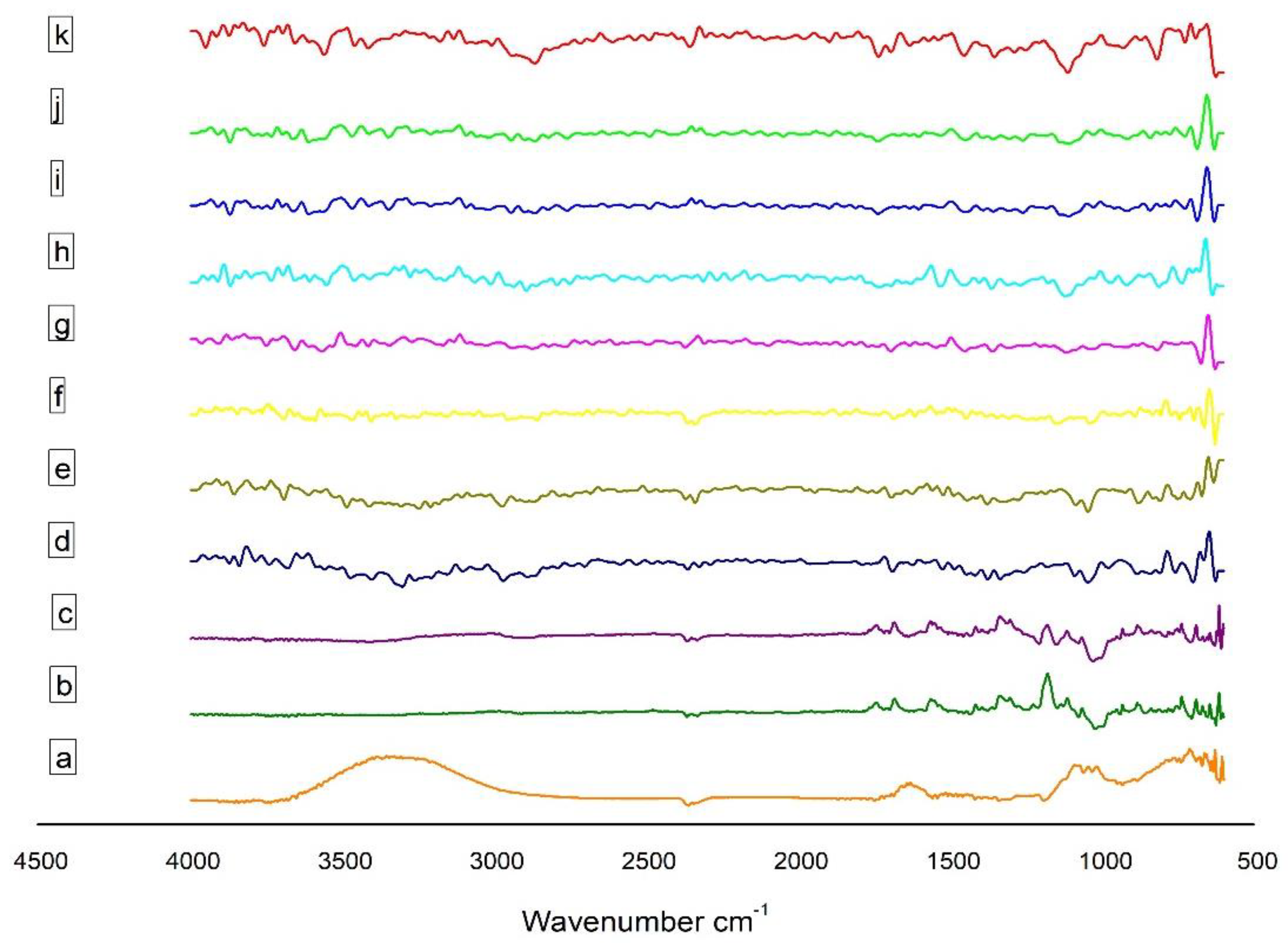


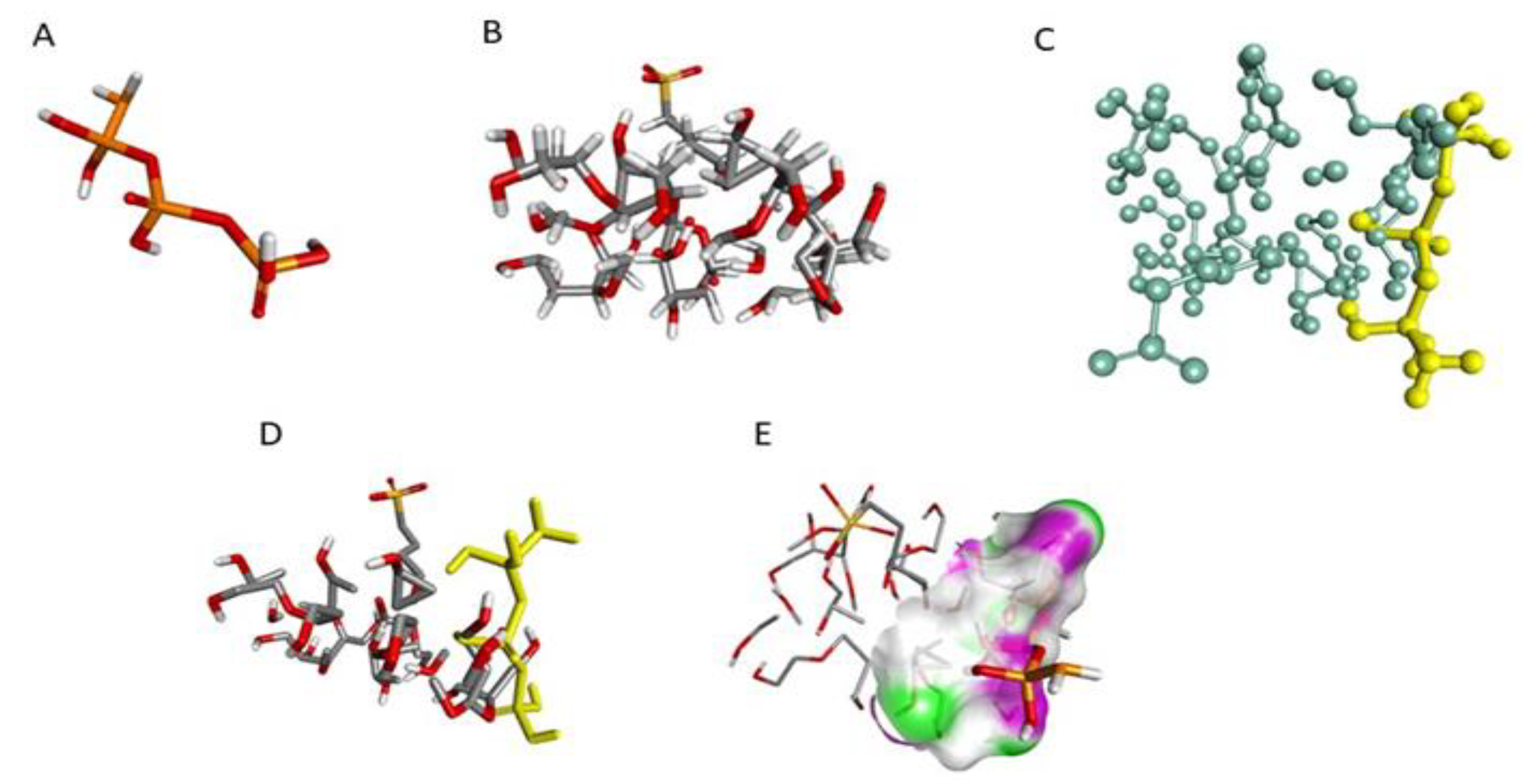
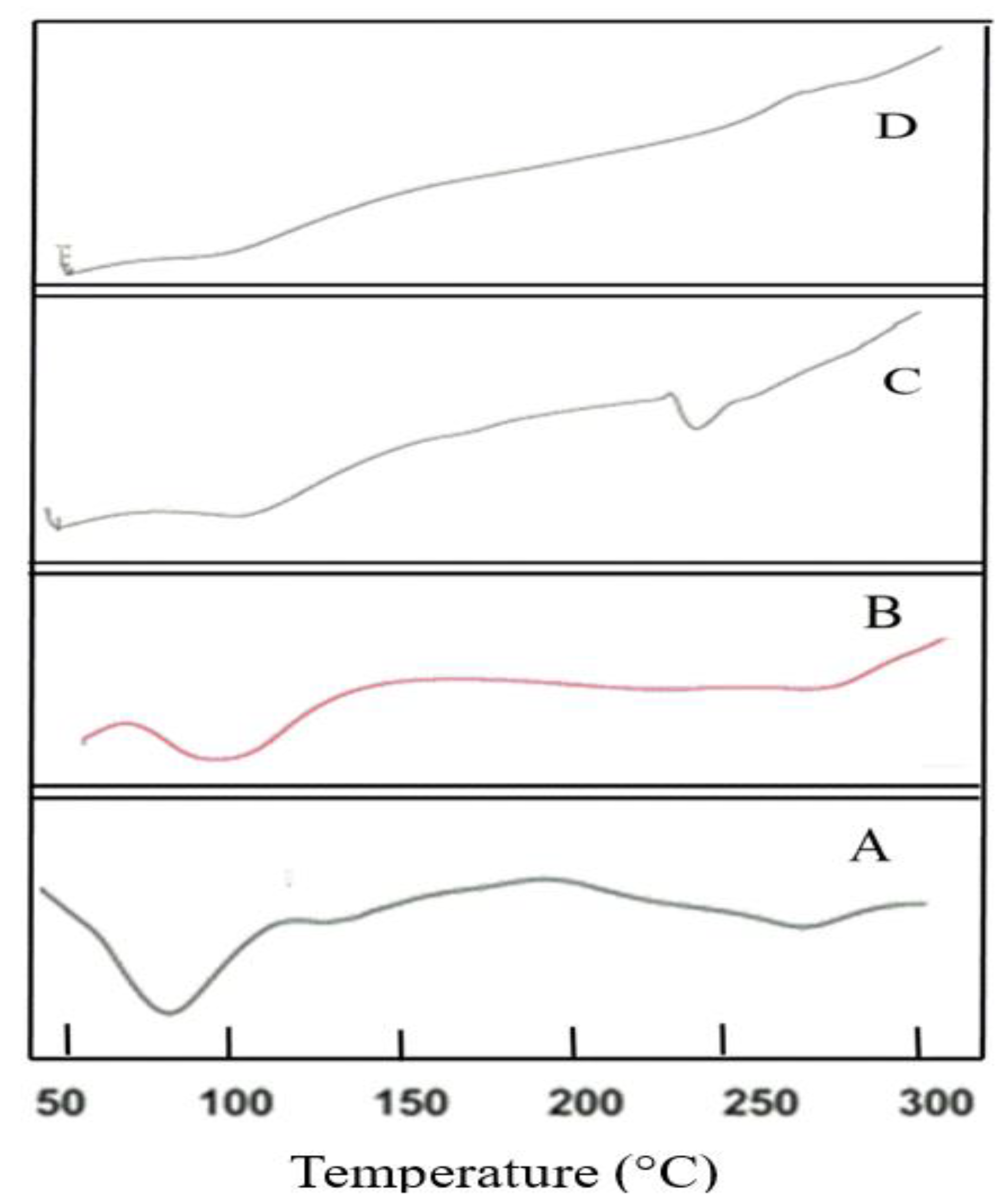
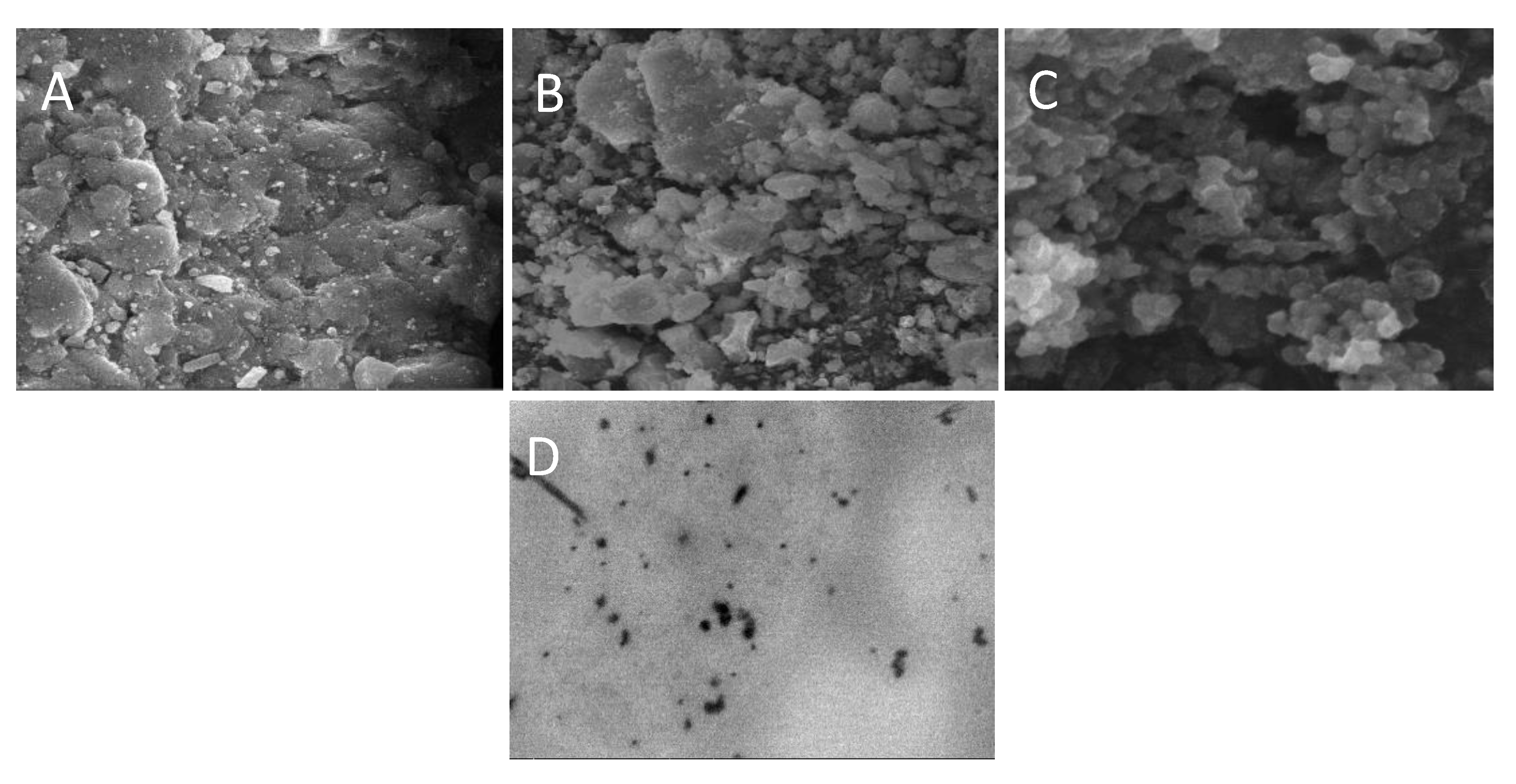

| Test Samples | Concentration of CS (%) | Vol. of sTPP (mL) | Concentration of AA (%) | pH of CS Soln. | Ratio of CS/sTPP |
|---|---|---|---|---|---|
| 1 | 0.1 | 1 | 2 | 3.6 | 5:1 |
| 2 | 0.1 | 1.5 | 1 | 3.6 | 5:1 |
| 3 | 0.2 | 1 | 2 | 3.6 | 5:1 |
| 4 | 0.2 | 1.5 | 1 | 3.6 | 5:1 |
| 5 | 0.1 | 1 | 2 | 4.6 | 6:1 |
| 6 | 0.1 | 1.5 | 1 | 4.6 | 6:1 |
| 7 | 0.2 | 1 | 2 | 4.6 | 6:1 |
| 8 | 0.2 | 1.5 | 1 | 4.6 | 6:1 |
| 9 | 0.1 | 1 | 2 | 5.6 | 7:1 |
| 10 | 0.1 | 1.5 | 1 | 5.6 | 7:1 |
| 11 | 0.2 | 1 | 2 | 5.6 | 7:1 |
| 12 | 0.2 | 1.5 | 1 | 5.6 | 7:1 |
| Coded Formulation | Description |
|---|---|
| NP1 | NPs prepared by PM using β-CD |
| NP2 | NPs prepared by PM using SBE7 β-CD |
| NP3 | NPs prepared by KM using β-CD |
| NP4 | NPs prepared by KM using SBE7 β-CD |
| NP5 | NPs prepared by CP using β-CD |
| NP6 | NPs prepared by CP using SBE7 β-CD |
| Test Samples | CS (%) | sTPP (mL) | AA (%) | pH of Soln. | CS/sTPP Ratio | NPs (nm) |
|---|---|---|---|---|---|---|
| 1 | 0.1 | 1 | 2 | 3.6 | 5:1 | 510 |
| 2 | 0.1 | 1.5 | 1 | 3.6 | 5:1 | 517 |
| 3 | 0.2 | 1 | 2 | 3.6 | 5:1 | 604 |
| 4 | 0.2 | 1.5 | 1 | 3.6 | 5:1 | 781 |
| 5 | 0.1 | 1 | 2 | 4.6 | 6:1 | 314.7 |
| 6 | 0.1 | 1.5 | 1 | 4.6 | 6:1 | 358.4 |
| 7 | 0.2 | 1 | 2 | 4.6 | 6:1 | 401.7 |
| 8 | 0.2 | 1.5 | 1 | 4.6 | 6:1 | 405.7 |
| 9 | 0.1 | 1 | 2 | 5.6 | 7:1 | 861.6 |
| 10 | 0.1 | 1.5 | 1 | 5.6 | 7:1 | 905.2 |
| 11 | 0.2 | 1 | 2 | 5.6 | 7:1 | 957.6 |
| 12 | 0.2 | 1.5 | 1 | 5.6 | 7:1 | 1048 |
| Formulations | Particle Size (nm) | PDI | Zeta Potential (mV) |
|---|---|---|---|
| NP1 | 348.4 | 0.578 | 35.4 |
| NP2 | 272.2 | 0.366 | 38.9 |
| NP3 | 263.1 | 0.493 | 22.7 |
| NP4 | 262.5 | 0.302 | 37.3 |
| NP5 | 247.5 | 0.327 | 31.8 |
| NP6 | 241.5 | 0.363 | 32.9 |
| Nanoparticles | EE (%) ± SD | Yield (%) ± SD |
|---|---|---|
| NP1 | 76.35 ± 0.002 | 44.28 ± 0.20 |
| NP2 | 77.96 ± 0.003 | 47.14 ± 0.21 |
| NP3 | 74.67 ± 0.002 | 45.71 ± 0.04 |
| NP4 | 77.58 ± 0.002 | 50 ± 0.25 |
| NP5 | 76.70 ± 0.002 | 48.57 ± 0.08 |
| NP6 | 80.72 ± 0.003 | 52.85 ± 0.09 |
| Formulation | Zero Order | First Order | Higuchi | Korsmeyer-Peppas | |
|---|---|---|---|---|---|
| R2 | R2 | R2 | R2 | n | |
| NP1 | 0.7300 | 0.9612 | 0.9615 | 0.9630 | 0.528 |
| NP2 | 0.7233 | 0.9725 | 0.9663 | 0.9671 | 0.521 |
| NP3 | 0.6516 | 0.9350 | 0.9683 | 0.9691 | 0.481 |
| NP4 | 0.6847 | 0.9717 | 0.9681 | 0.9843 | 0.499 |
| NP5 | 0.6451 | 0.9618 | 0.9576 | 0.9582 | 0.484 |
| NP6 | 0.5587 | 0.9655 | 0.9474 | 0.9533 | 0.451 |
| Parameters | Group A | Group B |
|---|---|---|
| Body Weight (kg) | ||
| Pre-treatment | 2.13 ± 0.14 | 2.18 ± 0.16 |
| Day-1 | 2.14 ± 0.19 | 2.18 ± 0.22 |
| Day-7 | 2.16 ± 0.27 | 2.19 ± 0.25 |
| Day-14 | 2.17 ± 0.25 | 2.20 ± 0.19 |
| Intake of Water (mL/day) | ||
| Pre-treatment | 179 ± 0.16 | 186 ± 0.24 |
| Day-1 | 180 ± 0.17 | 188 ± 0.21 |
| Day-7 | 183 ± 0.06 | 189 ± 0.33 |
| Day-14 | 185 ± 0.13 | 191 ± 0.35 |
| Intake of Food (g/Animal/Day) | ||
| Pre-treatment | 64 ± 0.06 | 65 ± 0.23 |
| Day-1 | 66 ± 0.09 | 64 ± 0.22 |
| Day-7 | 58 ± 0.17 | 62 ± 0.29 |
| Day-14 | 63 ± 0.14 | 66 ± 0.21 |
| Ocular Toxicity | ||
| Lacrimation | Nil | Nil |
| Salvation | Nil | Nil |
| Eye irritation | Nil | Nil |
| Miscellaneous Effects | ||
| Dermal toxicity | Nil | Nil |
| Hyperactivity | Nil | Nil |
| Convulsions | Nil | Nil |
| Touch reflexes | Present | Present |
| Corneal reflexes | Present | Present |
| Righting reflexes | Present | Present |
| Gripping reflexes | Present | Present |
| Alertness | Nil | Nil |
| Biochemical Analysis | |||
|---|---|---|---|
| Hematology | Units | Group A | Group B |
| Hb | g/dl | 14.5 ± 0.83 | 14.7 ± 0.94 |
| pH | 7.28 ± 0.03 | 7.30 ± 0.02 | |
| RBCs | 106/μL | 6.43 ± 2.15 | 6.46 ± 2.25 |
| TLC | 103/μL | 9.1 ± 1.91 | 9.5 ± 2.21 |
| Eosinophil | (%) | 2.3 ± 0.13 | 2.4 ± 0.22 |
| Neutrophil | (%) | 48.8 ± 1.29 | 49.3 ± 1.33 |
| Monocytes | (%) | 2.1 ± 0.11 | 2.2 ± 0.13 |
| Lymphocytes | (%) | 53.8 ± 1.41 | 57.6 ± 1.23 |
| PLT | 103/μL | 334 ± 0.15 | 340 ± 0.13 |
| MCV | (%) | 63.4 ± 1.28 | 64.4 ± 1.23 |
| MCH | pg/cell | 19.4 ± 1.01 | 19.6 ± 0.98 |
| MCHC | g/dl | 31.0 ± 0.73 | 30.7 ± 0.69 |
| Serum Biochemistry | |||
| Triglycerides | mg/dl | 44 ± 0.07 | 47 ± 0.09 |
| Total cholesterol level | mg/dl | 56 ± 0.17 | 62 ± 0.11 |
| Uric acid | mg/dl | 2.7 ± 0.14 | 2.9 ± 0.15 |
| Creatinine | mg/dl | 0.6 ± 0.03 | 0.7 ± 0.01 |
| ALT | U/L | 112 ± 1.26 | 113 ± 1.31 |
| AST | U/L | 74 ± 1.18 | 78 ± 1.09 |
| Groups | Heart | Liver | Lung | Kidney | Spleen |
|---|---|---|---|---|---|
| Group A | 4.36 ± 0.08 | 78.24 ± 0.17 | 9.13 ± 0.16 | 12.36 ± 0.02 | 1.07 ± 0.04 |
| Group B | 4.18 ± 0.06 | 82.19 ± 0.15 | 9.19 ± 0.17 | 13.13 ± 0.04 | 1.13 ± 0.02 |
Publisher’s Note: MDPI stays neutral with regard to jurisdictional claims in published maps and institutional affiliations. |
© 2021 by the authors. Licensee MDPI, Basel, Switzerland. This article is an open access article distributed under the terms and conditions of the Creative Commons Attribution (CC BY) license (https://creativecommons.org/licenses/by/4.0/).
Share and Cite
Alvi, Z.; Akhtar, M.; Rahman, N.U.; Hosny, K.M.; Sindi, A.M.; Khan, B.A.; Nazir, I.; Sadaquat, H. Utilization of Gelling Polymer to Formulate Nanoparticles Loaded with Epalrestat-Cyclodextrin Inclusion Complex: Formulation, Characterization, In-Silico Modelling and In-Vivo Toxicity Evaluation. Polymers 2021, 13, 4350. https://doi.org/10.3390/polym13244350
Alvi Z, Akhtar M, Rahman NU, Hosny KM, Sindi AM, Khan BA, Nazir I, Sadaquat H. Utilization of Gelling Polymer to Formulate Nanoparticles Loaded with Epalrestat-Cyclodextrin Inclusion Complex: Formulation, Characterization, In-Silico Modelling and In-Vivo Toxicity Evaluation. Polymers. 2021; 13(24):4350. https://doi.org/10.3390/polym13244350
Chicago/Turabian StyleAlvi, Zunaira, Muhammad Akhtar, Nisar U. Rahman, Khaled M. Hosny, Amal M. Sindi, Barkat A. Khan, Imran Nazir, and Hadia Sadaquat. 2021. "Utilization of Gelling Polymer to Formulate Nanoparticles Loaded with Epalrestat-Cyclodextrin Inclusion Complex: Formulation, Characterization, In-Silico Modelling and In-Vivo Toxicity Evaluation" Polymers 13, no. 24: 4350. https://doi.org/10.3390/polym13244350
APA StyleAlvi, Z., Akhtar, M., Rahman, N. U., Hosny, K. M., Sindi, A. M., Khan, B. A., Nazir, I., & Sadaquat, H. (2021). Utilization of Gelling Polymer to Formulate Nanoparticles Loaded with Epalrestat-Cyclodextrin Inclusion Complex: Formulation, Characterization, In-Silico Modelling and In-Vivo Toxicity Evaluation. Polymers, 13(24), 4350. https://doi.org/10.3390/polym13244350







